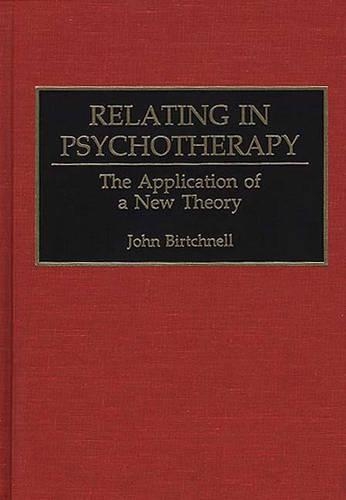
Relating in Psychotherapy: The Application of a New Theory
(Hardback)
Publishing Details
Relating in Psychotherapy: The Application of a New Theory
By (Author) John Birtchnell
Bloomsbury Publishing PLC
Praeger Publishers Inc
28th February 1999
United States
Classifications
Tertiary Education
Non Fiction
Social, group or collective psychology
616.8914
Physical Properties
Hardback
288
Description
In his earlier book, "How Humans Relate", John Birtchnell proposed that relating occurs along two axes, a horizontal one concerning becoming close versus being distant and a vertical one concerning being upper versus being lower. He called closeness, distance, upperness and lowerness the relating objectives, and he proposed that people need to acquire competence in attaining and maintaining these objectives. In this work, he argues that the task of psychotherapists is to identify and correct, within these axes, people's relating incompetencies, and to enable people to cope with the relating incompetencies of others. He considers this to be the case across all psychotherapies. The text proposes the existence of an unconscious, automatic inner brain that monitors the relating objectives. Birtchnell argues that the psychotherapist assists the person, through the conscious, outer brain, to correct and improve the inner brain's least effective relating strategies. He uses the term interrelating to describe the interplay between the relating of two or more people. This has application in couple, family, group and community therapy, in which the psychotherapist's task is to enable the interrelaters to understand and correct their mutually reinforcing, destructive interactions. He introduces a set of questionnaires, from the scores of which a computer can print out an easy-to-read diagram of the direction and degree of people's relating incompetencies.
Reviews
"A significant step forward in the integration of the psychotherapies, which now replaces the old heroic age of a few charismatic figures (and their warring bands of followers) as the cutting edge of progress in the field. It is also a great pleasure to read, especially because of the wealth of human observation which it incorporates."-D. Macdiarmid, Senior Fellow in Psychotherapy Guy's Hospital Medical School, London
What is rewarding about this book is the structural clarity and simplicity of its perspective....It is as a book on the craft of psychotherapy that the book can be even more highly valued.-British Journal of Medical Psychology
"What is rewarding about this book is the structural clarity and simplicity of its perspective....It is as a book on the craft of psychotherapy that the book can be even more highly valued."-British Journal of Medical Psychology
Author Bio
JOHN BIRTCHNELL is Senior Lecturer at the Institute of Psychiatry, De Crespigny Park, London. Involved in full-time psychiatric research since 1967, Dr. Birtchnell has edited the British Journal of Medical Psychology as well as numerous journal articles and a companion volume How Humans Relate: A New Interpersonal Theory (Praeger, 1993).
